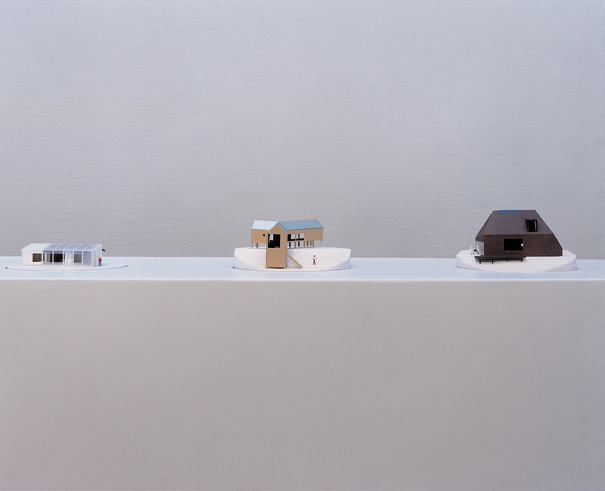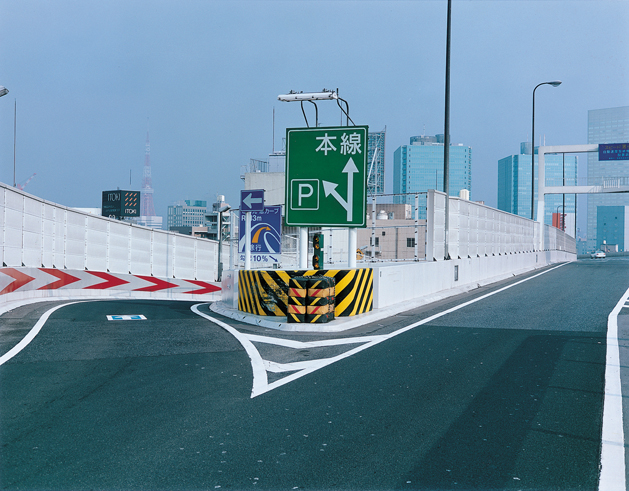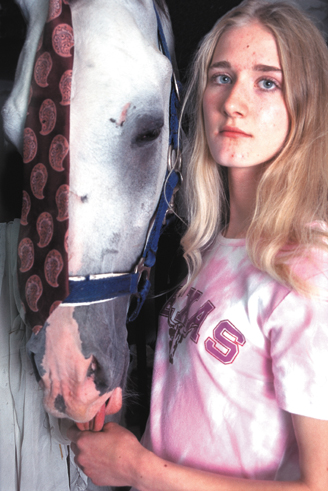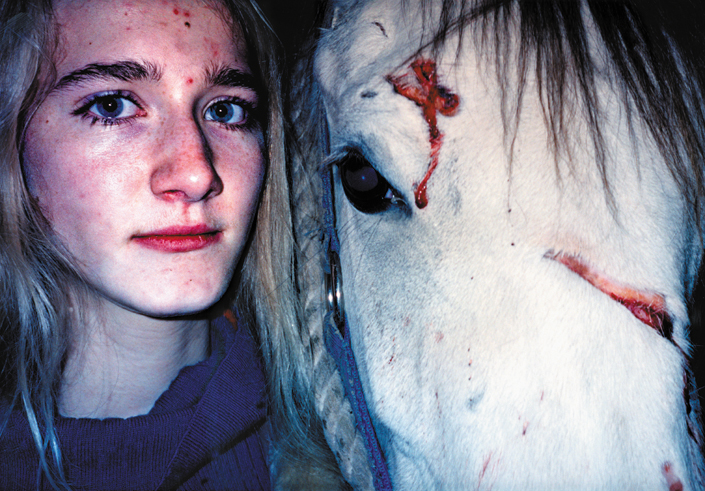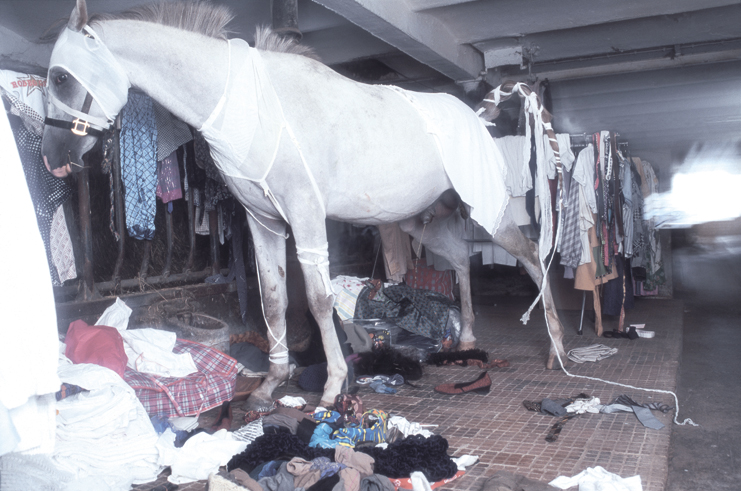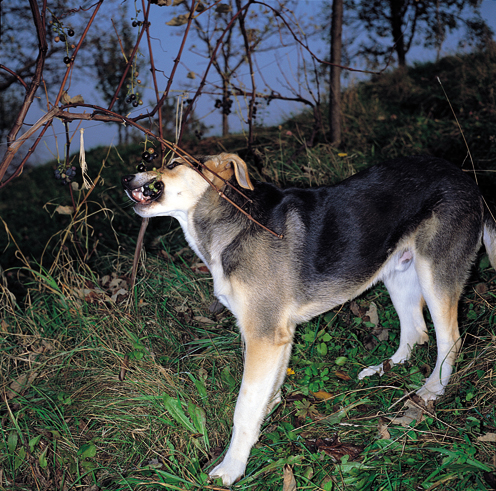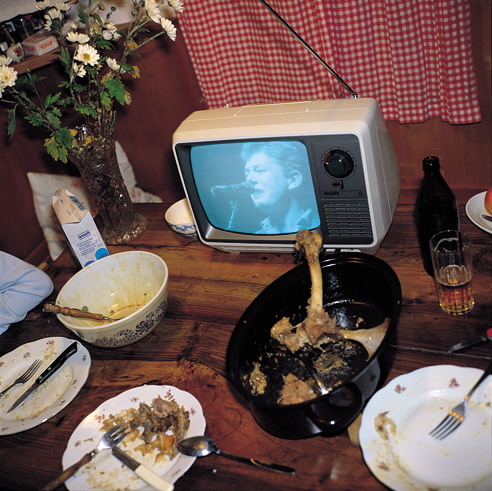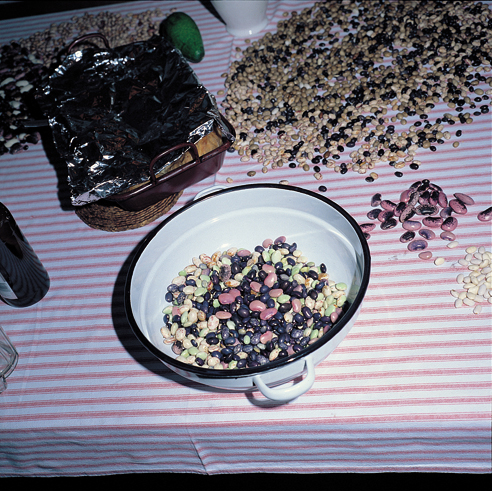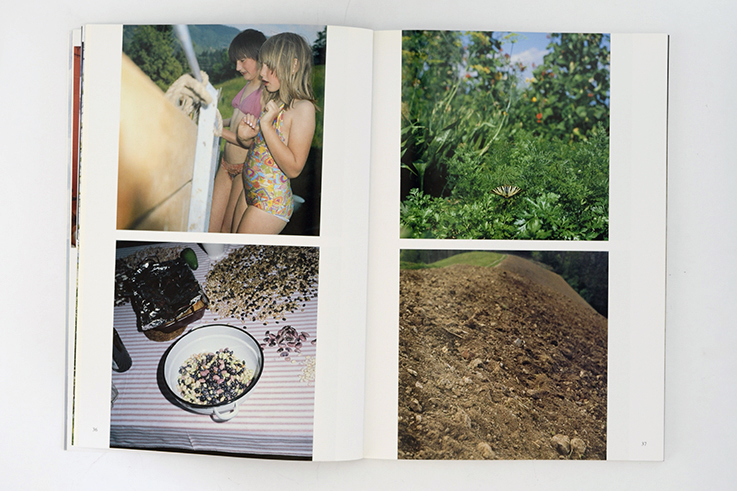Camera Austria International
77 | 2002
- SHINO KURAISHI
The Membrane of Cities and Architecture: Takashi Homma's Photographs - TAKASHI HOMMA
- JAN VERWOERT
The horse farm - a counterworld: On Alexandra Vogt's Photography - ALEXANDRA VOGT
- MARTIN PRINZHORN
Manfred Willmann: Ideology Critique - MANFRED WILLMANN
- KRYSTIAN WOZNICKI
Rhetoric of loss of control - MANUEL OLVEIRA
Herman Asselberghs_Els Opsomer_Rony Vissers: Mondophrenetic TM., So, where are you coming from?
- ROLF SACHSSE
BILD - HAUT - NETZ. Feuchte Fotografie: Schleimhaut und Blitz

Preface
In his essay on the works of Manfred Willmann, Martin Prinzhorn begins by spotlighting the difficult relation between the town and the country in contemporary art production: the country is usually either incapable of dialogue with the remaining, urban part of culture or serves merely as a projection surface for quite different yearnings and fears of mainstream culture. Nevertheless, we have invited artists to contribute to this issue who, among other things, deal with this very relation in their work. In this context, Willmann’s work is an example of the unmasking of the, as Prinzhorn says, fantastic nature of constructed contrasts between “town” and “country”: just as it seems impossible today to represent a construction of the “town” by an accumulation of stereotypes (of which “modern art” is doubtless one), the construction of the “country” does not act as a counterweight. In his pictures vom Land, of the country – photographs taken over a period of ten years –Willmann pursues a strategy allowing him to circumvent the many snares inherent in the subject by focusing on details. This approach makes it difficult for the viewer to reconstruct the harmonious whole that makes up the country construct.
Read more →Camera Austria International 77 | 2002
Preface
In his essay on the works of Manfred Willmann, Martin Prinzhorn begins by spotlighting the difficult relation between the town and the country in contemporary art production: the country is usually either incapable of dialogue with the remaining, urban part of culture or serves merely as a projection surface for quite different yearnings and fears of mainstream culture. Nevertheless, we have invited artists to contribute to this issue who, among other things, deal with this very relation in their work. In this context, Willmann’s work is an example of the unmasking of the, as Prinzhorn says, fantastic nature of constructed contrasts between “town” and “country”: just as it seems impossible today to represent a construction of the “town” by an accumulation of stereotypes (of which “modern art” is doubtless one), the construction of the “country” does not act as a counterweight. In his pictures vom Land, of the country – photographs taken over a period of ten years –Willmann pursues a strategy allowing him to circumvent the many snares inherent in the subject by focusing on details. This approach makes it difficult for the viewer to reconstruct the harmonious whole that makes up the country construct.
The Japanese photographer Takashi Homma is similarly de-ideologizing in his work: his depictions i.a. of Japanese suburbs in his work “Tokyo Suburbia” are not created with the intention of showing the suburb as a place of uprooted, temporary life, associated with the classical social phenomena and characteristic artistic “high-brow sensibility” for ugliness and dehumanized suburban environments that range somewhere between nature and artificiality– on the contrary: counter to these traditional perceptions of suburbia, to Homma –according to the author of the essay accompanying this contribution, Shino Kuraishi – this place has by now become an everyday space quite simply to be lived in, without intervening with specific critical judgements. In Homma’s works, he says, there is no indication of a constructed Other – the country, for instance – that might serve as a projection surface for something, for example “home”.
Herman Asselsberghs, Els Opsomer and Rony Vissers take a different approach, setting out to analyse in very concrete terms the definition, construction and analysis of the links between some characteristic features of our culture from the viewpoint of their immediate (urban) environment, among other things in their multimedia interactive spatial installation “Mondophrenetic?”. As artists, critics, producers and designers they are concerned with incorporating political, economic, sociological, philosophical and information technology aspects into their work, thus getting a focus on the contradictions of our contemporary globalised system of culture. Here, the urban space is interpreted as a depersonalised anonymous typology whose foundations were laid in the functionalist planning fantasies of the seventies.
“The horse farm – a counterworld” is the title of Jan Verwoert’s article on the work of Alexandra Vogt, whose works we will also be featuring as part of the Current Art project in Graz this April, in an exhibition to be held at Galerie Camera Austria. Vogt’s photographs, whose chief figures are horses and young girls, are created in a close, ongoing co-operation with the protagonists on the former farm of the “English Ladies” convent in Mindelheim, Bavaria, where the artist lives and works. Her works are “determined by a tension”, Verwoert says, “built up by the clash of two aesthetics of photography: the exaggerated enactment of a story and plain photographic representation. What we see can be interpreted as the documentation of scenes that might take place like this or differently on real horse farms and, on the other hand, as a re-enactment of fantasies transported by books or films of fairy-tales. But it is precisely this oscillation between reality and fantasy that characterises the world that Alexandra Vogt describes. The world of teenagers who live out their fantasies and yearnings with horses. On the one hand, then, the horse farm is a very real place (…) on the other hand, the horse farm and holidays in the country constitute a romantic counterworld to uniformed everyday life at school and at home, a world linked to the ideal of being free.”
Again we are accompanying the monographic artist contributions with a theoretical piece –following and loosely linked to Reinhard Braun’s essay “Because I’m worth it. Speculations on visual discourses and consumer cultures” (featured in Camera Austria 74/2001). In “Rhetoric of loss of control” Krystian Woznicki looks into the semiotic consequences of September 11, 2001. After hitting the World Trade Center and the Pentagon, key symbols of the American self-image, Al Qaeda was alleged to have certain affinities to brand activist activities that usurp the sign system of globalised pop culture, turning it against the existing order of things. However, Woznicki unmasks these strategies as Western allocations that not only allowed the West to criminalize opponents of globalisation, but which also result in a new standard of militarization of the economy of signs.
During work on this issue of Camera Austria we received news of Pierre Bourdieu’s death and, shortly afterwards, of the death of Inge Morath. We had ties with both figures, whom we held in great esteem, in the form of projects whose results are to be presented in various exhibitions in Graz in 2003. We deeply regret this loss and will make every effort to continue and implement their projects according to their wishes so as to live up to their trust in us. Pierre Bourdieu discussed the approach he took in the photographic documentation “Algérie 60” in an in-depth interview with Franz Schultheis in Camera Austria 75/2001 –now it is up to us to collate Pierre Bourdieu’s extensive photographic archive and the available (in some cases as yet unpublished) writings under this project and to find a form of implementation that does justice to this unique undertaking. News of Inge Morath’s death took us by surprise in the middle of talks on the conception of the exhibition of her photographs taken in the Austro-Slovenian border area (with which she has ties due to her parents’ origin) in 2001. The “Grenz.Räume” (border spaces) project – which, in addition to the exhibition of these photographs, will feature a film about Inge Morath and her work and a comprehensive book publication – will be taking place as a main programme item in Graz 2003.
Camera Austria is taking part in the following international art fairs this year: Armory Show, New York; SPE-Conference, Las Vegas; Art Basel; Art Forum, Berlin; Kunst Wien, Vienna; Art Cologne and Art Basel Miami Beach. We look forward to intensifying our exchange with readers, authors and artists and to presenting our original artist editions on these occasions!
Christine Frisinghelli, Maren Lübbke, February 2002
Entries
Forum
ANNE HARDY
PIETRO SANGUINETI
MACDONALDSTRAND
DORIS KRüGER
LYDIA LENZENHOFER
MAMORU TSUKADA
JULES SPINATSCH
ALEXANDER HONORY
Exhibitions
William Eggleston
Fondation Cartier pour l’art contemporain, Paris
ANNE BERTRAND
Liz Larner
Museum of Contemporary Art (MOCA), Los Angeles
SANDRA WAGNER
The Garry Winogrand Game of Photography
Center for Creative Photography, Tucson, Arizona, USA
MARGARET REGAN
Hans Danuser: Frost
Fotomuseum Winterthur; Scalo, Zürich / Berlin / New York
THILO KOENIG
Gebrauchswert und Eigensinn
Timm Rautert: Arbeiten.
Museum der Arbeit, Hamburg
KERSTIN STREMMEL
Bis auf den Grund der Oberfläche: Werkschau Thomas Ruff
Fotografien 1979 bis Heute
u.a. Kunsthalle Baden-Baden; Museum Folkwang Essen; Museet for Samitdskunst, Oslo
LOTHAR SCHMIDT
Dorit Margreiter – Everyday Life
Galerie im Taxispalais, Innsbruck
SØNKE GAU
Angst
Ursula Blickle Stiftung, Kraichtal; Grazer Kunstverein
ULRICH TRAGATSCHNIG
6. Internationale Fototage Herten
ANGELA ACHILLE
Hannah Villiger
Bonner Kunstverein; Kunsthalle Basel
MAGDALENA KRÖNER
24 – Positionen russischer Architekturfotografie
Moskauer Architekturmuseum; Moskauer Haus der Fotografie
HERWIG HÖLLER
Ein gusseisener Schnappschuss Jeff Walls »Lost Luggage Depot«
Kop van Zuid, Rotterdam
SVEN LÜTTICKEN
Rethorik der Überwachung von Bentham bis Big Brother: CTRL [SPACE]
ZKM, Karlsruhe
RUTH NOACK
The Waste Land. Wüste und Eis. Ödlandschaften in der Fotografie
Atelier im Augarten, Österreichischen Galerie Belvedere, Wien
SUSANNE NEUBURGER
Robert Adrian X
Kunsthalle Wien
NINA SCHEDLMAYER
DREI HAMBURGER MONOGRAFIEN
Museum für Kunst und Gewerbe, Hamburg: Andreas Feininger, Lotte Genzsch, Natascha A. Brunswick
BURCU DOGRAMACI
Televisions – Kunst sieht fern
Kunsthalle Wien
REINHARD BRAUN
Für die lieben Kolleginnen. Moira Zoitl
Kunstverein Wolfsburg
KARIN PERNEGGER
25. Duisburger Filmwoche
JAN VERWOERT
Boris Mikhailov: Case History. Haus der Kulturen der Welt, Berlin;
Boris Mikhailov: TV Mania. Galerie Barbara Weiss, Berlin
CHRISTIANE MEIXNER
Abbild – Recent Portraiture and Depiction
steirischer herbst, Landesmuseum Joanneum, Graz
MAREN LÜBBKE
Books
Linda Hentschel: Pornotopische Techniken des Betrachtens
Jonas Verlag, Marburg 2001
SIGRID ADORF
Den Foto(ge)schichten der Person zur Publikation “Cora Pongracz: Fotografie”
Galerie im Taxispalast Innsbruck / Edition Fotohof Salzburg, 2001
MARIE RÖBL
Wolfgang Zurnborn: Dressur Real
Zeit-Sprung-Edition, Potsdam 2001
WOLFGANG VOLLMER
Verwandlungen durch Licht
Rundbrief Fotografie, Sonderheft 6, Esslingen 2001
FRIEDRICH TIETJEN
Terry Eagleton: Was ist Kultur?
C.H. Beck, München 2001
RAINER METZGER
Imprint
Publisher: Manfred Willmann. Owner: Verein CAMERA AUSTRIA, Labor für Fotografie und Theorie
All: Sparkassenplatz 2, A-8010 Graz
Editors: Christine Frisinghelli, Maren Lübbke, Heidi Oswald
Editorial assistants: Daniel Barthmann, Eva Missenbäck, Anja Rösch
Translations: John Doherty, Wilfried Prantner, Richard Watt, Josephine Watson, Sumiko Yamakawa

